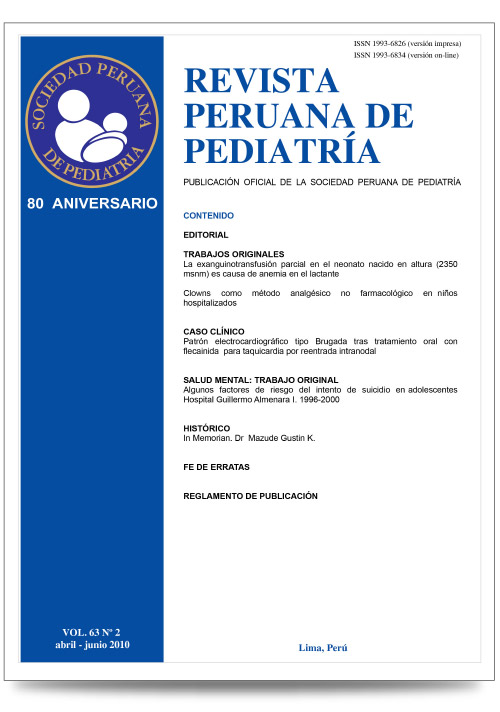Clowns as analgesic pharmacological method in hospitalized children
DOI:
https://doi.org/10.61651/rped.2010v63n2p09-19Abstract
Background: One of the most relevant negative aspects that experiment children during hospitalization, are the painful procedures which they undergo. This generates fear and increases the levels of anxiety. Diverse non- pharmacological methods exist to diminish the intensity of pain.
Objectives: The aim of this study was to determine the effect of a Group of Clowns as a non-pharmacologic analgesic method during painful procedures.
Material and Methods: Two groups of hospitalized children were studied: Clown Group (n=30) and control Group (n=38). Each Group was stratified according to ages: children of 2 to 6 years old, and 7 to 16 years old. The intervention consisted in the interaction of a pair of Clowns (Doctores Bola Roja) during the painful procedure. The intensity of pain was measured with 2 scales: The Children’s Hospital of Eastern Ontario Pain Scale (CHEOPS) (in the younger ager group, 2 to 6 years old) and Self Assessment Scale (in the older age Group, 7 to 16 years old). It was also measured variations of heart rate and oxygen saturation 60 and 30 seconds before painful stimuli, during painful stimuli and, 30 and 60 seconds after painful stimuli. The strategies used by the Clowns were registered.
Results: The Clown Group showed significantly less intensity of pain than the control Group; children of 2 to 6 years old: score 5.56 (clown Group) versus 11.79 (control Group) p < .0001; children of 7 to 16 years old: score 1.14 (clown Group) versus 4.17 (control Group) p< .0001. It was found statistical significant differences in the Oxygen Saturation and Heart rate curves between the two groups. The diminution of the pain in the Clown Group was independent to age.
Conclusions: This study shows that the presence of a Group of Hospital Clowns during venous sampling in the first day of hospitalization in children from 2 to 16 years old was an effective method to decrease pain intensity of such procedure, as compared to a control group. There was significant correlation between physiologic parameters and pain intensity.
Downloads
Downloads
Published
How to Cite
Issue
Section
Categories
License

This work is licensed under a Creative Commons Attribution 4.0 International License.
Authors will retain the copyright and grant the right to publish their work in the journal while allowing third parties to share it under the Creative Commons Attribution license.
Articles are published under a Creative Commons license that allows sharing and adaptation with appropriate credit. CC BY 4.0 license. Available in English at https://creativecommons.org/licenses/by/4.0/
Authors may use other information disclosure formats as long as the initial publication in the journal is cited. The dissemination of the work through the Internet is recommended to increase citations and promote academic exchanges.
The published content does not necessarily reflect the specific point of view of the journal, and the authors assume full responsibility for the content of their article.




